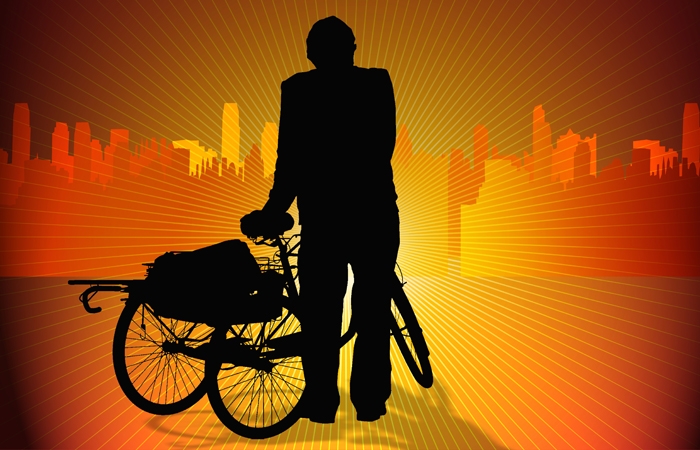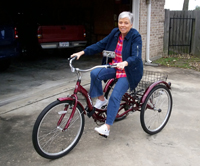
CMT: To Exercise or Not to Exercise?

The author’s weight loss surgery led her to start an exercise program that provided her with more muscle tone — and a lot of fun
To exercise or not to exercise? I can almost hear the people reading this article screaming, “NOT!” Truthfully, until about a year ago, I would have been screaming NOT the loudest, the longest and with absolutely no hesitation.
Living with CMT
 I have been affected by Charcot-Marie-Tooth disease (CMT) since birth. I have not known a single moment without dealing with CMT. Learning to walk as a toddler came later than most, and with many more falls. Riding a bicycle was out of the question for me because my balance was just nonexistent. Don’t get me wrong, not all people with CMT are unable to ride a bike. My sister and my daughter both ride a bicycle, and both have CMT. My granddaughter and I just never could manage the whole “balance and lean” thing, and we got really tired of picking gravel and dirt out of our knees, hands, elbows, ankles, hips … Well, you get the picture.
I have been affected by Charcot-Marie-Tooth disease (CMT) since birth. I have not known a single moment without dealing with CMT. Learning to walk as a toddler came later than most, and with many more falls. Riding a bicycle was out of the question for me because my balance was just nonexistent. Don’t get me wrong, not all people with CMT are unable to ride a bike. My sister and my daughter both ride a bicycle, and both have CMT. My granddaughter and I just never could manage the whole “balance and lean” thing, and we got really tired of picking gravel and dirt out of our knees, hands, elbows, ankles, hips … Well, you get the picture.
So — along with playing any sport, riding a bicycle, running and jumping rope — pretty much any outdoor activity was, for me, a “no-go.” Or so I thought.
OK, so hold on to your neck to keep from getting whiplash and fast-forward 50-plus years. I really can’t complain about my life, even with CMT. I married a wonderful man, raised two beautiful children, had a great job as the manager of a company, which resulted in me owning my own company for more than 10 years, and now, have the most precious granddaughter that the good Lord could put on this Earth. That’s not too shabby, huh?
A ticking time bomb
Well, here’s when CMT kicked in with a vengeance. As CMT’s slow progression over the years resulted in lack of activity, my weight went through the roof. It became a vicious circle: My balance got worse, falls were more frequent, sitting and not moving became the norm, resulting in huge weight gain. Now filter in depression, overeating, knee pain (resulting in total knee replacement), fear of falling, more sitting, more eating, more depression … I was a ticking time bomb, just waiting on that fall that would break a hip or a leg, and that would take forever to heal with CMT.
I hit a point in my life where I knew I had to take drastic measures. On Feb. 14, 2012, I had the weight loss surgery called the “gastric sleeve.” Before scheduling the procedure, I talked to my primary care physician and neurologist to get their thoughts and opinions. Both of them were very supportive and felt that losing the extra weight would help my balance issue and lessen my risk of falling. With my doctors’ and family’s full and total support, I had the surgery and three-quarters of my stomach was removed.
But, my surgeon warned me that just because I only have a quarter of my stomach left, it does not mean I didn’t have to diet and exercise.
Making healthy choices
I considered joining a health club, but was always overwhelmed by the number of people there and always felt extremely self-conscious of the way I walked and did my routine. So instead, I created my own workout at home, using a treadmill, stationary bike and some moderate weight resistance exercises. I worked out five to six times a week, doing 20-30 minutes of moderate strength training, and the same on the treadmill and the bike. I cannot go fast on my treadmill and it’s an old one without an auto incline button, so my husband built incline ramps for me. I figured the incline made up for the lack of speed. I was totally diligent about my workouts and felt guilty when I missed them for any reason.
My doctor was absolutely right: The weight was really dropping off, and not just from decreased portions. The next time I went to see my neurologist to have her check the progression of my CMT, she noticed a significant improvement in the strength of my legs. She was so excited and kept rechecking it. I am sure you can understand why it almost brought me to tears to hear this news.
After a while, I got tired of riding a stationary bike and bought myself an adult three-wheel tricycle — a beautiful, red Schwinn tricycle that I have named Scarlett. Scarlett and I ride around my neighborhood every day and lately, twice a day. Each ride is four miles (clocked by driving the route in my car). I get some funny looks from a few people, but mostly lots of waves and smiles. Twenty years ago, I would have been too embarrassed to ride a giant tricycle, but at 57 years old, I just pedal away knowing that I am doing more than entertaining the neighbors. I am maximizing my strength and losing weight. So far, I have lost 114 pounds and have six more to lose to reach the goal my doctor set for me.
And you know what? It’s fun! No wonder kids like to ride bikes. As a child, I never got to experience that, so Scarlett and I are having the time of our lives.
So now when someone asks the age-old question “exercise or not?” I most definitely scream the loudest, the longest and with absolutely no hesitation: EXERCISE.
This will surely depend on your doctors’ approval and recommendations, but for me, what little I do (compared to what a person without a neuromuscular disease can do) is worth every sweaty moment.
A Doctor's Perspective
 Neurologist Michael Shy is an MDA research grantee at the University of Iowa and co-directs the MDA Clinic at the University of Iowa Hospitals & Clinics. Shy explains that "low-impact exercise will not make CMT go away but may very well help many patients live a better quality of life."
Neurologist Michael Shy is an MDA research grantee at the University of Iowa and co-directs the MDA Clinic at the University of Iowa Hospitals & Clinics. Shy explains that "low-impact exercise will not make CMT go away but may very well help many patients live a better quality of life."
Here's what else he has to say on the subject:
"We often discuss exercise and weight control with our patients, but there are some caveats," Shy says. "While it seems clear that being fit and watching one's weight would be ideal for patients with CMT, there is not a lot of quality data on this point. Investigating the proposed benefits of exercise in CMT is one of the aims in our Inherited Neuropathies Consortium that MDA helps support.
"In general, we recommend low-impact exercises such as bikes, stationary bikes and swimming, since they are easier on ankle and knee joints then treadmills, for example. We worry about arthritis down the road for already stressed joints. Many patients also feel benefit from stretching exercises and activities, such as yoga."
Shy is a longtime MDA grantee with a particular interest and expertise in CMT. He has current MDA support to develop and maintain the Inherited Neuropathies Consortium, a network of CMT research centers jointly funded by MDA and the National Institutes of Health. The Consortium is designed to develop standards of care for CMT and related disorders, conduct research to develop new treatments in these diseases, and train the next generation of CMT researchers.
MDA Resource Center: We’re Here For You
Our trained specialists are here to provide one-on-one support for every part of your journey. Send a message below or call us at 1-833-ASK-MDA1 (1-833-275-6321). If you live outside the U.S., we may be able to connect you to muscular dystrophy groups in your area, but MDA programs are only available in the U.S.
Request Information